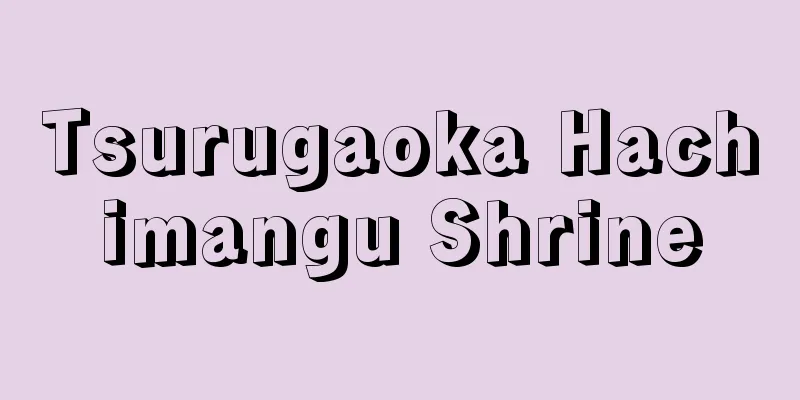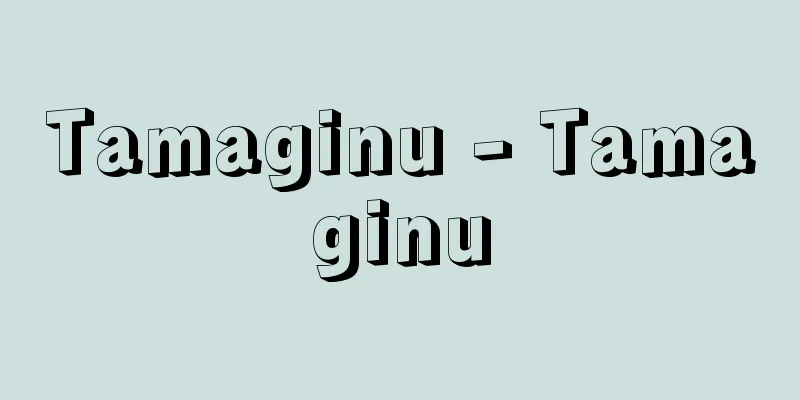Tsurugaoka Hachimangu Shrine

|
It is located in Yukinoshita, Kamakura, Kanagawa Prefecture. The shrine enshrines Emperor Ojin, Hime-no-kami, and Empress Jingu. In 1063 (Kohei 6), Minamoto no Yoriyoshi invited Iwashimizu Hachimangu Shrine (currently a sub-shrine, Yui Wakamiya) to Yui-go, Kamakura, and in 1180 (Jisho 4), Minamoto no Yoritomo raised an army in the eastern provinces and entered Kamakura, and moved the shrine to its current location in Kitayama, Kobayashi-go, and established it in the center of the city of Kamakura. Since then, Hachimangu Shrine has been the spiritual pillar of the Kamakura Gokenin as the guardian shrine of the Minamoto clan and the Shogunate, and has become the site of the Shogunate's official events. As the Kamakura Shogunate developed, the organization was improved, and a betto (chief priest) and 25 guso (attendant priests) were appointed. As it is also called "Tsurugaoka Hachiman-gu Temple," it is a shrine in the style of a palace temple, which is a typical example of syncretism between Shinto and Buddhism, and although the Otomo clan was the chief priest, authority within the shrine was held by the monks (soryo). In 1191 (Kenkyu 2), the main shrine building was burned down, so the mountainside behind the shrine was cut open and the main shrine (Kamimiya) was built. Wakamiya (Shimomiya) at the foot of the mountain and a sub-shrine were also built, giving the shrine a new look. The famous incidents include the dance of Shizuka Gozen in the Wakamiya Corridor and the murder of the third shogun, Minamoto no Sanetomo, by the chief priest Kugyo at the head of the shrine. The shrine was deeply revered by successive shoguns, and even after the fall of the Kamakura Shogunate, the Ashikaga Shogunate's Kamakura shogunate, the Gohojo clan during the Sengoku period, and the samurai continued to worship the shrine, with Hojo Ujitsuna, Toyotomi Hideyoshi and others building and repairing the shrine buildings. In recent years, the remains from that time have been excavated. The separation of Shinto and Buddhism in the Meiji era hit the shrine hard and it was temporarily impoverished, but after the Second World War, especially in the 1960s, the population increased and the shrine recorded the highest number of first visits of the year in Japan for eight years. The shrine's treasures include the Magaki ni Kikuraden Makie Suzuribako (Magakinikikuraden Makie Suzuribako) and the Masatsune sword (both national treasures). The annual festival, in which three Momoyama period portable shrines (prefectural cultural properties) are paraded, is held on September 15th, and the Yabusame ritual is held on September 16th. [Soji Okada] Yabusame at Tsurugaoka Hachimangu Shrine has been a tradition since the Kamakura period. It is performed twice a year, at the Kamakura Festival in April and the Yabusame Shinto Ceremony in September. An archer dressed in samurai hunting attire gallops on horseback and shoots at three targets placed on the riding ground. The photo shows Yabusame at the Kamakura Festival. Kamakura City, Kanagawa Prefecture © Kamakura City Tourism Association "> Yabusame Ritual at Tsurugaoka Hachimangu Shrine Source: Shogakukan Encyclopedia Nipponica About Encyclopedia Nipponica Information | Legend |
|
神奈川県鎌倉市雪ノ下に鎮座。祭神は応神(おうじん)天皇、比売(ひめ)神、神功(じんぐう)皇后の3座を祀(まつ)る。1063年(康平6)源頼義(よりよし)は鎌倉由比(ゆい)郷に石清水八幡宮(いわしみずはちまんぐう)を勧請(かんじょう)(現在の末社由比若宮)し、1180年(治承4)源頼朝(よりとも)は東国に挙兵し鎌倉に入ると、社を小林郷北山の現社地に遷(うつ)し、都市鎌倉の中心に据えた。以後八幡宮は、源氏の氏神、幕府の守護社として鎌倉御家人(ごけにん)らの精神的支柱とされ、幕府の公的行事の場となった。鎌倉幕府の発展に伴って機構が整備され、別当、25坊の供僧(ぐそう)などが置かれた。「鶴岡八幡宮寺」とも称されているように、神仏習合の典型である宮寺形式の神社であり、神主に大伴(おおとも)氏が補せられていたものの、社内の権限は僧侶(そうりょ)が握っていた。 1191年(建久2)社殿を焼失したため、裏山の中腹を切り開いて本社(上宮)を造営、山下の若宮(下宮)、摂末社も整い、面目を一新した。若宮回廊における静御前(しずかごぜん)の舞、社頭にて別当公暁(くぎょう)に3代将軍源実朝(さねとも)が殺された事件は有名。歴代将軍家の崇敬厚く、鎌倉幕府滅亡後も、室町幕府の鎌倉府の足利公方(あしかがくぼう)、戦国期の後北条(ごほうじょう)氏と、その信仰に怠りなく、北条氏綱(うじつな)、豊臣(とよとみ)秀吉らによって社殿の造営や修理が行われるなど、武士の尊崇を集めた。近年、そのときの遺構が発掘されている。明治の神仏分離によって打撃を受け、一時疲弊したが、第二次世界大戦後とくに昭和40年代の初詣(はつもう)で人口の増大にのって、8年間初詣で日本一を記録した。社宝には籬菊螺鈿蒔絵硯箱(まがきにきくらでんまきえすずりばこ)、正恒(まさつね)銘の太刀(たち)(いずれも国宝)などがある。県文化財の桃山期神輿(みこし)3基の渡御する例大祭は9月15日、流鏑馬(やぶさめ)神事は9月16日。 [岡田荘司] 鎌倉時代より伝統を受け継ぐ鶴岡八幡宮の流鏑馬。年に二度、4月の鎌倉まつりと9月の流鏑馬神事で披露される。武士の狩装束に身を包んだ射手が馬で駆けながら、馬場に配された三つの的を射抜く。写真は鎌倉まつりの流鏑馬。神奈川県鎌倉市©鎌倉市観光協会"> 鶴岡八幡宮の流鏑馬神事 出典 小学館 日本大百科全書(ニッポニカ)日本大百科全書(ニッポニカ)について 情報 | 凡例 |
<<: Tsuruoka Hojoe Artisan Poetry Contest - Tsuruoka Hojoe Artisan Poetry Contest
>>: Tsuruoka Shrine Records - Tsuruoka Shrine Records
Recommend
Private house - Minka
A home for ordinary people. It often refers to a ...
Konko Daijin
Religious reformer and founder of Konkokyo. Born ...
Archilochus colubris (English spelling)
…The incubation period is 14 to 19 days. One repr...
Adam Schaff
1913‐ Polish philosopher. After graduating from Lv...
Ambrosius - Ambrosius (English spelling)
Bishop of Milan. One of the Four Doctors of the W...
Eme Saru - Eme Saru
…Vowel assimilation is a very characteristic feat...
High sumo wrestler - Kourikishi
A eunuch from the prosperous Tang Dynasty in Chin...
Operating loss - Eigyosonshitsu
A state in which operating profit is negative, and...
Kusatsu oyster stock - Kusatsu oyster stock
…By chance, during the great fire of Osaka in Dec...
Steering gear - steerer
…(1) Steering gear Ships are equipped with steeri...
Sotokaifu and Uchikaifu Coast - Sotokaifu and Uchikaifu Coast
The coastline from Hajikizaki, the northernmost po...
Sterilization - Mekkin (English spelling) sterilization
Physical and chemical methods are used to create a...
Remains - Iko (English) structure
Among the traces left by humans, those that cannot...
EC Court of Justice
…European Union [Tanaka Toshiro]. … From the Cour...
Shin Kusakawa
1893-1948 A composer from the Taisho to early Sho...



![Kanchenjunga [mountain] - Kanchenjunga](/upload/images/67cb4b012c20d.webp)



![India [Country] (English spelling) India](/upload/images/67caf6ebecc49.webp)

